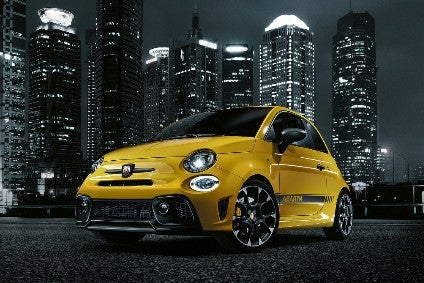
Has FCA found the secret recipe for turning small cars into big profits? It would seem so, with sales of the premium priced Abarth 500 range climbing ever higher, even though the basic Fiat model is more than a decade old.
Abarth sales in Europe are up by 47 per cent for the year to the end of August.
Abarth, which FCA has reinvented as an exclusive division selling Fiat models at anything but bargain basement prices, is having a great year across Europe. It’s not possible to see the picture in North America as Fiat Chrysler took the decision to make Abarth a trim level there. That was a wise move given the costs associated with setting up and maintaining yet another brand for the group. Not to mention Toyota’s unhappy experience with Scion, which started out chasing the same sorts of customers.

Discover B2B Marketing That Performs
Combine business intelligence and editorial excellence to reach engaged professionals across 36 leading media platforms.
The majority of Abarth models retailed in EU and EFTA countries are versions of the Fiat 500, with numbers for the year to end of August showing 13,977 cars delivered, a year-on-year surge of 65 per cent for the month and a 47 per cent rise for the year to date. The brand is especially popular in Italy but the UK is another place where the cars with the scorpion logo find ever greater favour. Given that the Fiat 500 has been in production since 2007, this is an extraordinary achievement.
Did FCA look at how Porsche keeps the 911, Boxster and Cayman selling? It certainly could have and why wouldn’t this serve as a useful tactic to copy? Adding high-priced limited editions – there have even been Abarth 500s with Maserati and Ferrari links – and making the cars look genuinely different to the basic Fiats upon which they are based, has been a stroke of genius.
The 595 Competizione looks friendly, lean and above all, fast.
People might not always be willing to hazard a guess at the pronunciation – officially, it’s supposed to be Ah-BART – but everyone who saw the little 595 Competizione while it was in my care knew the brand. That, money cannot buy. It comes from word of mouth, or rather, keystrokes and images inserted into digital media feeds. Another key factor is in making the cars, and the 500 is the best example of this, look friendly, lean and above all, fast. Yet with a strong hint that there is hidden giant-slaying potential too. Which is why from every angle, you see a scorpion when you look at a 595 Competizione. Might the Abarth 595 be the car version of Mo Farah?
Separate numbers for Fiat and Abarth were not available within the data (supplied by JATO) but no matter, the combined European markets total of 135,038 units of the Fiat 500 and Abarth 500 over the year to the end of August is impressive enough. In August, registrations numbered 10,733 cars, a year-on-year gain of 24 per cent. Even less than 10 per cent of these being the Abarth versions is going to mean tidy profits, when in the UK, the cheapest 500 to wear the scorpion badge costs a minimum of GBP14,700. You can spend as much as GBP35,897 on a 695 Biposto Record edition. Buyers tend to go in heavily for options and accessories too. It’s also proving to be a good year for the brand in Britain, with Abarth registrations up by 12 per cent to exactly 3,500 cars.
The 595 Competizione is probably the best of the range, in that it’s not as hard-core as the 695 Biposto, which only has two seats and is really a track day car. Even though you know this is just a Fiat 500, somehow the Abarth touches change the way this A segment hatchback feels – it isn’t just a convincing set of exterior differences.
The ride is probably the thing which may prevent some from falling for a Competizione. For me, it was fine, only the occasional thump from the shorter travel and harder springs-dampers suspension set up showing that there are compromises for having way, way less roll than the Fiat original.
FCA should have praise heaped upon it for having honed the Fiat 500 into what is a truly great little rocket ship.
The dashboard manages to look better, and if it that doesn’t necessarily mean high end, the seats do a great job of building in a sporty and expensive feel. The steering wheel looks the part too, and really only the small infotainment screen gives away the car’s age. There was no navigation system in the test car and you must park by beep rather than cameras’ views. As this is such a small vehicle, that’s no drama.
Even when you don’t push the big SPORT button on the dashboard, the 595 loudly clears its throat every time it’s fired up. The 180PS 1.4-litre turbo engine has a surprisingly bellowing tone to it, the standard ‘Monza’ exhaust system being loud if you want it to be, or with SPORT deactivated it’s not too intrusive. Zero to 62mph takes 6.7 seconds yet it feels faster.
The 595 Competizione has only a couple of faults: the 185 litre boot will be too small for some, and the turning circle is maddeningly big for such a tiny vehicle. It’s rare to find a car with such a heavy dose of character from a mass manufacturer. FCA should have praise heaped upon it for having honed the Fiat 500 into great-handling tiny tearaway.






